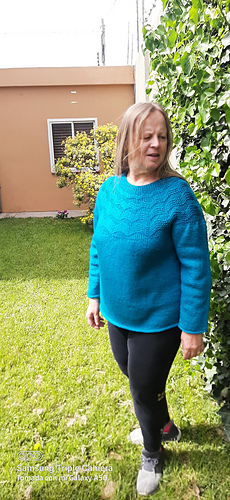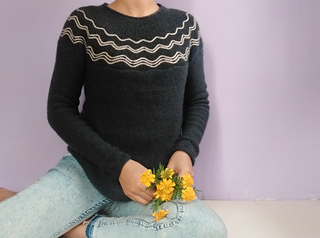patterns >  Oregon Forests Collection and 2 more...
Oregon Forests Collection and 2 more...
> Oregon Forests Sweater

















Oregon Forests Sweater
I’m currently having trouble paying through Ravelry, my patterns can be purchased on Boosty (see the link in Source)On this site you pay for the post, it contains a PDF file with the English version of the pattern. I will also send you the pattern via Ravelry so that it will be saved in your library throughout the day. Sorry for the temporary convenience
ABOUT THE PATTERN
One evening I was swatching some slip-stitch textured patterns in plushy emerald-green yarn, while in the background my teenage daughters were re-watching the first Twilight movie. Next morning I looked at my swatches and realized I was unconsciously trying to replicate the gorgeous rolling hills covered with pine forests and swirls of mist that I saw in the movie (filmed in Oregon, hence the pattern name).
This thin but warm pullover is exactly what you need for a walk in the fall in a forest or urban jungle.
CONSTRUCTION
The yoke is knit flat sideways in garter stitch with short rows for shaping and slip-stitch print (can also be done in a contrast color). It is then seamed at the back and trimmed with I-cord along the neck opening. Smallest children sizes have a button closure at the back to make putting it on easier.
After that, selvedge edge stitches are picked up and back is raised for a better fit (using more short rows). Sleeves are separated from the body, casting on extra stitches in the underarms.
Body is worked straight (A-line & fitted mods possible – see Appendix) top-down in the round with optional horizontal bust darts. The hem is finished with I-cord bind-off to mimic the yoke.
Sleeves are also knit top-down in the round with two shaping options: slightly tapered, or bishop-style, both options finished with a garter cuff and I-cord bind-off.
MATERIALS AND TOOLS
Yarn: sport-weight to DK wool (can be 200-350m/220-380yds per 100g/3.5oz, as long as it gives gauge).
There is a pattern modification for print in one or multiple contrast colors (see sample photo below).
I do NOT recommend using 100% superwash merino or >50% alpaca as those might sag considerably in wear.
Choose yarns with little to no halo to best show off the print. You can use a solid / tonal, but I would avoid highly variegated as it will “muddy” the print.
The sample was knit out of ‘Yak Mel’ by Pecci Filaty (70% merino, 30% yak; 650m/700yds per 100g/3.5oz – held double); colorway ‘Malachite’.
Needles:
• Main: 3.5mm/US4 (or size to get stockinette gauge) circulars on a 40-100cm/16-40” cable, depending on the size worked + DPNs for the sleeves, if you prefer them to magic loop (for magic loop you may need 0.25mm / 1 US size larger needles);
• Smaller: 3mm/US2.5 (or ~0.5mm/ 2 US sizes smaller than main) same cable length as the main ones + DPN’s for the I-cords on the neckband, hem and cuffs.
I-cords: most knitters use a smaller needle, but if you are a very tight knitter, you might even have to go up a needle size for I-cord – make sure to check that it lays flat and goes over the head easily.
Notions: waste yarn, crochet hook, cable needle (optional), stitch markers, row counter, tape measure, tapestry needle, scissors; for children sizes up to and including 6-7 y.o. – 1 button (~8-12mm/ ¼-½” in diameter)
GAUGE (PER 1010CM/ 44” AFTER WET-BLOCKING)
• Stockinette: 20 stitches by 32-34 rows (depends on your yarn qualities) – on main needles;
• Garter stitch: 20 stitches by 40 rows (20 garter ridges) – on smaller needles

1790 projects
stashed
2012 times
- First published: November 2021
- Page created: November 2, 2021
- Last updated: May 14, 2025 …
- visits in the last 24 hours
- visitors right now





